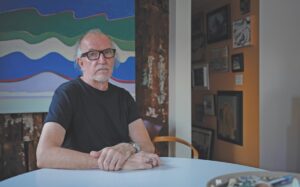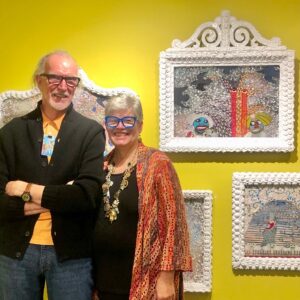David Perry flies under the radar. He’s an architect, designer, collector, and curator whose aesthetic decisions have made aquariums and zoos beautiful and more accessible.

He now works backstage advising gallery owners on what work to exhibit and divining how best to display the art. You may walk through sports museums Perry helped to design without knowing that he created the flowing path through the exhibit spaces in Foxboro’s Patriot Place and as far afield as Lisbon, Osaka, and Kuwait. His taste is polished and sure-footed.
A fresh example of his behind-the-scenes work is on view right now in Provincetown. He curated and installed the widely praised show of Deb Mell’s art that continues through the first week of December at the Berta Walker Gallery. It inspired this comment from writer and gallery owner Howard Karren: “Arguably the most exciting and beautiful and sumptuous show — truly fabulous — that I’ve ever seen in Provincetown.”
Perry is six feet four and striking with his distinctive graying ponytail. He’s long been a familiar figure on the Outer Cape art scene, yet many people don’t know his name. He’s unassuming and welcoming.

Sharon Basco: I understand you are a Midwesterner.
David Perry: I grew up in the Upper Peninsula of Michigan in a remote mining town that became a ghost town when the mines pulled out.
My grandma Peterson was my mentor. She taught me to look and listen. She had the sweetest advice about getting through life: “Just keep your eyes open.” Not “Speak up,” and not “Mind your peace.” Just keep your eyes open. See things, observe things, see what you like.
She came from Sweden in 1909 to Iron River, Mich., the little town I grew up in. She was a young girl who rode in on a buckboard — that’s a horse-drawn working farm wagon. She saw a lot. She lived to see people walk on the Moon.
SB: You went to architecture school in Michigan. When did you leave?
DP: I finished my fifth-year degree in 1976. Detroit was on the skids big-time, and in 1976 architecture wasn’t happening in Detroit. My college housemate got a job in New Hampshire — she was an art teacher — and was going to move. So, I said, “Well, I’ll move to New Hampshire.” I lived there for a year and a half.
Then I went to Provincetown with a friend and fell in love with it. I met some people, friends of friends, who were minor executives in some crazy Manhattan firm. They came to Provincetown and bought a run-down motel. They asked me to come and help them.
SB: You were designing for them?
DP: No, I was cleaning rooms, cleaning toilets, running around, booking rooms. There were three of us, and none of us knew how to run a motel. We didn’t know what we were doing, but we had really clean rooms.
Ed Arruda, the guy who was the brains behind it, was a brilliant businessman, so he just worked through it and made a huge success and went on to buy lots of property in Provincetown and run businesses.
After that stint in Provincetown, I decided I needed to get a real job. I left Provincetown and eventually got a job at Cambridge Seven. It was fascinating because it’s a multidiscipline firm. I did model building and then architecture and then graphic design and exhibit design and habitat design for zoos and animals. I was there a long time, but it was a lot of different jobs.
SB: And you designed aquariums?DP: I worked on a lot of aquarium jobs all over the world. I would sculpt the artificial habitats that the animals lived in and design graphics and the whole exhibit experience, coming up with themes and movement through the museum.
SB: How did you get involved with Patriot Place?
DP: We did the Basketball Hall of Fame in Springfield early on, and the Tennis Hall of Fame in Newport, and the New England Sports Museum at Boston’s TD Garden. We had credentials for sports, and when the request for proposals went out, we jumped at it.
SB: You and your longtime partner, Richard Larkin, spend half your time in Boston and half in the Truro house you bought years ago.
DP: We bought the place in ’98, and from there on, for 10 or 15 years, I was working full-time and traveling everywhere. But then we got four-day work schedules, and eventually when I retired, I could stay even longer.
Someone gave us advice as far as fitting in in a new place: “Just get involved, join things, be visible. Don’t wait for people to come with welcome baskets of fruit.”
So, we did. We joined everything there was to join: the Truro Historical Society, the Friends of the Truro Library, and conservation groups. And it worked.
Getting involved directly with artists was the next step.
SB: You ran the Berta Walker Gallery?
DP: Working for Berta was great. But the next step for me was to work with people individually, helping them get shows, curating shows.
SB: Who are some of the artists you’ve worked with?
DP: There were many Nancy Ellen Craig shows, including at PAAM, the Cape Cod Museum of Art, the Groton School. At the Berta Walker Gallery, I worked with Paul Resika, Sal Del Deo, Bob Henry and other wonderful artists — Laura Shabott, Diane Messinger, Ellen Anthony, and Donna Pomponio, to name a few.
SB: How would you describe your relationship with the artists you advise? Is there consistency in what you do with them? Do you have to be a psychologist?
DP: Well, the consistency for me is that I need to have time to investigate, to look at the work before the artist tells me what they’re all about. I look at the work and build some sort of emotional connection to it. If that’s not there, it’s tough for me to understand the artist. And if I don’t understand them, I can’t help them in any way.
SB: Are there artists about whose work you might say, I know it’s good but it’s just not for me?
DP: Yes. It’s a tough thing to come to that point because I don’t want to give up, but I also know that I can’t advise them very intelligently if I don’t have an appreciation of it.
It happens occasionally that it just doesn’t do anything for me so I can’t really engage. And I hope that I’m always honest with artists.
SB: It seems as if you’re really involved but kind of offstage.
DP: I think I’ve always been that way. I want to know a little bit about everything and then maybe find something that I want to expand upon, to investigate more. I keep my eyes open, and I see something new, or I move on.
SB: Just as your grandmother told you. How long did you run the Berta Walker gallery?
DP: I was the manager for five seasons, which is pretty long for a retirement job. And I was thrilled when Berta asked me to curate the Deb Mell show that’s up now. It’s been getting great reviews and was just extended to Dec. 3. Berta gave me full range, full control. I was able to show Deb’s work in all of its levels — she’s a painter, a sculptor, she works in 3D and multimedia.
SB: Looking back over the years, was there a turning point in your life?
DP: I always had a clear idea that I had to leave my small-town life behind. I was going to go out and be doing something somewhere else in the world. I had to become independent. And I realized I had to be proactive and find a happy path through life. You have to move on, you have to do something different, or it’s never going to get any better.



